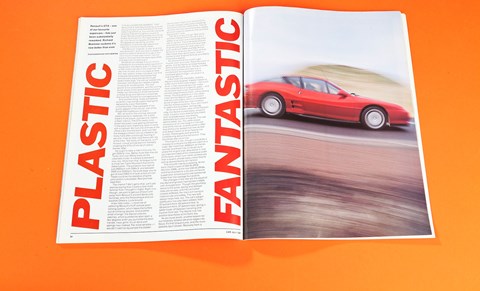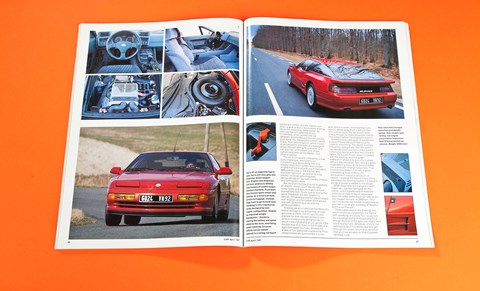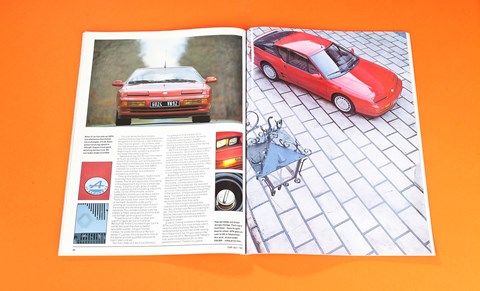► Renault GTA Turbo becomes the Alpine A610
► Hefty revamp includes bigger engine, new interior
► One of our favourites is now better than ever
It is an uncertain moment. That Renault 25 is definitely following us as we swoop along a rather fine French D-road ribboning before us. You can tell, because its driver flashes his lights a couple of times. We are travelling briskly, but not as briskly as the devil in my head wants us to go. Our mount is capable of more than the speeds we are doing, and the temptation to sink the right pedal and clear the mirrors is hard to resist.
The Renault, however, is new, blue and very persistent. And it is hard to assess the sartorial state of its driver through a four-inch chunk of rear-view mirror. I do not want to discover that he wears epaulettes and regularly fondles a gun. Whatever his interest, it is not hard to understand. It’s certainly a striking piece of equipment, this Alpine, even if it does look a little more ordinary in the nose than the last one.
It’s sad, but in our eyes at least, this new version is less individual now that it has the retractable headlamps that almost every Japanese sports coupe wears these days. The old car looked very dramatic with those twin sheets of glass housing its candle-power. The rear spoiler is too protuberant, and the cooling ducts ahead of the rear wheels look plain messy, too reminiscent of the handiwork of those Swiss and German companies that butcher Ferraris for outrageous sums.
And another thing: those wonderfully eccentric clap-hands wipers have gone, replaced by a pair that sweep conventionally. They were part of the quirky appeal of the old car, one of the things that helped you to love it.

Still, an end to this whining, because there’s plenty to celebrate. For a start, there’s more power, and second, there’s a fresh interior. The GTA needs more power because it was getting left behind in the pace race. Especially when it came with a catalyst. We had one of those at the office a few months back, and I can feel the disappointment now as it failed to go really hard after a thorough flooring in second. I had an Alfa-mad friend with me at the time. ‘Not really all that quick, is it?’ he said. I could almost see him mentally crossing the GTA off his list of cars to hanker after.
He ought to take a ride in this one. It’s got 250bhp now, 50bhp more than the old Turbo and over 60bhp extra on the cleansed model. A catalyst is standard now, too. More than that, its torque curve is more like Table Mountain than some distant peak. The parabola now tops at just 2900rpm with 258lb ft, and between 2000 and 5200rpm, the blurb says, you’ve got at least 246lb ft of twist action on call. These could be the statistics of some ultra-potent turbodiesel. Real promise here then.
The interior? We’ll get to that. Let’s just start by saying that it looks a little more familiar than I thought it might. Right now, though, we want to get out of town and away from Renault’s ancient Seine-side factories, onto the Peripherique and out towards Orleans, Loire-bound.
A few little notes — I never tire of admiring Renault’s PLIP remote door-locking system, which takes the fumble out of climbing aboard. And another small change: the Alpine’s electric catches, which pushed the door open a few degrees when you punched the door handle, have gone. It’s all done with springs now instead. Far more sensible — I wouldn’t want to rejuvenate the broken electric door catch of an ancient GTA, though I always harboured a sneaking admiration for their irrelevance. They’re up there with rain-sensitive screen wipers and walnut picnic tables on the list of silly toys found in cars.
The V6 is no toy, though. With a full 3.0 litres instead of the old car’s 2.5, it settles to an even and surprisingly slow idle on ignition. It sounds quite smooth, and has the sucking whine that all rear-engined cars seem to have, even junk such as Simca 1000s and NSU Prinzs. Since it’s a noise you don’t hear all that often these days (good news, when it comes to rear-engined Simcas and NSUs) it has extra appeal.
It’s obvious that this motor’s got muscle, even at a crawl. Feed the clutch in gently, and the Alpine will edge forward without any throttle at all. Handy in traffic jams. So is a clear (ish) view out, a comfortable driving position and a malleable gearchange — unusual in a mid-engined car.
A few miles into the traffic, and the Alpine’s looking good. It doesn’t seem to suffer much from turbo torpor—not much at all, in fact, because you can make near-instantaneous lunges for gaps — and its controls have a well-matched and smooth weightiness to them, without being heavy. The only problems in the urban crawl are the Alpine’s girth, and vision over your shoulders, which is hampered by the shape of the rear side windows. Use the mirrors carefully, if you don’t want to add to the facelifters’ reshapings.
Once we’ve shaken clear of the Parisian clog, the Alpine cruises easily, as you’d hope. It seems more directionally stable than its predecessor, less readily distracted by bumps and gusts. The ride seems better, too. You were always conscious of all that weight in the rear end of the old car, and the same is often true of this one, except that now its rear end doesn’t seem to sit so heavily into bumps. Passengers were prone to complaining about this behaviour. They should be less vocal now.
The engine is, too, though it would be a mistake to compare the Alpine’s cabin to a crypt. Get more than 4500rpm on the rev counter and there’ll be no doubt as to where the engine lives. Stay below it, and you’ll be reminded of the impressive width of the tyres, which hum more vociferously than a swarm of killer bees unless they’re rolling aboard freshly lain tarmac.
This shouldn’t be so surprising. At the front, there’s a pair of 205/45 ZR16 Michelin MXXs, at the rear 245/45 ZR16s, and they’re bolted to a double wishbone suspension whose bushes are somewhat firmer than the average fruit pastille. The changes in the ride are the result of the Alpine engineers having had a fiddle with its suspension.
Though the geometry remains the same, spring and damper rates are revised, and the car’s steel chassis stiffened, the main aim being to improve ride and safety. The new tyre design helps here, too. The car’s weight distribution has also been altered, from 37-percent front, 63-percent rear, to 43-percent front, 57-percent rear, giving a better trade-off between handling and traction from rest. The Alpine now has positive downforce at the front, too.
As we cruise south, another reason for our relatively relaxed advance edges into focus. It’s that torque curve, and the more speedily spun blower. Recovery from a baulking is swifter, and the need to slot down a gear or two is diminished, making life on the motorway rather easier. So does the Alpine’s splendid stereo, incidentally, which comes with six speakers and the Renault remote-control stalk for all the important functions (apart, that is, from switching it on, which is a bit of an omission) and sufficient wattage to drown the wail of engine and tyres. Our car also has a CD player, one of two options available on the Alpine —the other is leather.

The list of inclusions in the price is now quite impressive, and runs to air-conditioning (a good thing, with that steeply raked front screen and a blown engine that’s almost with you in the cabin), ABS brakes (new to the Alpine), and standard fare such as central locking, electric windows (which squeak excruciatingly on our car), electric mirrors and folding rear seats.
But we didn’t borrow this car to perform an electric motor count. We are after some twists and dips. And we find them somewhere near Tours. Just to add some spice, the roads are wet. Glistening tarmac, immensely powerful turbocharged rear engines and fat rubber don’t always mix well. Something to do with the pendulum effect.
Anyway, we don’t discover the Renault’s lateral aerodynamic properties, or even get close to them, The thing’s too well planted for that, too well sorted to turn vicious unless you’re being foolish, in which case it probably would gyrate if the throttle was shut down in the middle of a tight turn taken too hard. Modest tail slides at low speed are a possibility if too many horses are summoned in a low gear, which is worth remembering if you want to speed away from a wet junction onto a main road. The tail moves fairly slowly, though, so there should be time to haul it back before the palpitations set in.
A more containable gush of excitement is yours if there are some fast country roads to wind along. The Alpine is simply brilliant fun along these, first because it can handle them and second because it communicates so well. You don’t have to fight it, for a start. Power doesn’t interfere with the steering, and the weight distribution allows it to dive into corners without any hesitation. Not having a great understeering mass at the front to battle into a direction change helps here. That the rear end doesn’t turn into a great oversteering mass is Renault’s achievement and your salvation, of course — instead, the Alpine’s responses are sharp, the steering neutral if a sizeable dollop of power is added to the recipe.
What helps here is the engine’s swift response — use the right gear for the corner, and it’s pretty easy to keep the motor on or near to boost, especially when the turbo starts blowing hard, which can happen as early as 2000rpm. You can’t modulate the throttle as precisely as you can in a car with a battery of Webers, but this isn’t far off.
There’s precision in the steering, too, which allows you to position the Alpine with satisfying accuracy. You could aim for a postage stamp and probably hit it, though the size of the tyres just might have a role to play here. Whatever, it’s fun, not least because of the terrific feel you get through the wheel, which is so sensitive that you’ll be amazed to find it’s power-assisted. I was.
You can sense the front wheels surmounting bumps, the resistance climb as speed and lock build, a little slither as they hit some gravel – it’s all there. And the rear wheels you can feel through your seat. It’s not hard to sense when they’re beginning to slide, something which on dry roads they resist mightily.
Needless to say, the Renault rolls about as much as a dinghy in dry dock, has chairs that hold you well and brakes that stop it fast and fadelessly, even if they’re a bit dead in heavy use now that ABS is installed. It’s a car that’s meant to be driven hard and fast, and entertains wonderfully when it is.
Talking of entertainment, there’s more to be had from the noises the Alpine makes. The V6 isn’t absolutely intoxicating in this department, but it has a pleasingly meaty, if slightly rough, growl at higher revs, overlaid by the whooshing hiss of the turbo. Come off the throttle, and the wastegate’s release sounds like a distant whip-crack. It doesn’t end there, either. There are noises even when the Alpine is dormant, its electric water pump whirring as coolant is circulated to balm the blower and the fans spin to chill the radiators. You wonder whether a strong battery is fitted, because this whirring duet can be kept up for a good half-hour.
Those fans cut in after we stop and watch a figure get out of that blue Renault 25. There’s no need to get out the wallet; because this man is neither epaulette-wearer, nor gun-fondler. Instead, he works for the local Renault dealer in Loches. He only wants to look at the Alpine at close quarters because he hasn’t seen one yet. Our man asks us if we mind driving to his garage so that the rest of his colleagues can take a look. So we do. They are certainly keen, though communication trouble prevents us finding out what they think of the styling changes and the new interior.
We think the cabin is not good enough for a car this exotic. What lets it down is that it’s so unrelentingly grey and plasticky, even if some of the mouldings are more substantial now, the instrument binnacle and centre console cubby lid in particular. Good points include the new stalks – lifted from the Clio -the leather-wrapped wheel, and the fact that the trip computer is now triggered from the wiper stalk.
Bad points are the flimsiness of the remote-control stalk for the hi-fi, the absence of a permanent clock (incredibly, it shares space with the radio’s frequency display), the awkward handbrake, the vagueness of the markings on minor instruments and the cheapness of the seat trim. Cheapness everywhere really. You detect a lack of commitment here, even if the mechanicals are decisively better than they were.
The limited changes are probably indicative of a realistic assessment of just how few of these cars Renault is going to sell. This facelift probably didn’t cost a fortune, because it’s relatively easy to change the shape of a car that’s hand-made from plastic.
Close to nobody’s heard of Alpines or GTAs, and those who have simply view it as some obscure plastic Renault that looks good but wouldn’t be worth waving the cheque-book for. It’s got cred on the street, but not off it. ‘Renault GTA? What’s that, some limited-edition 21 on zero percent finance?’ There’s no justice.
